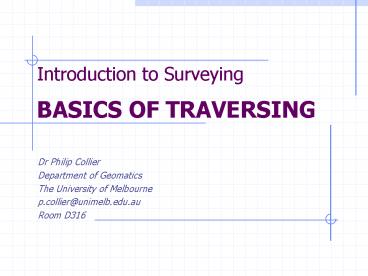Introduction to Surveying BASICS OF TRAVERSING - PowerPoint PPT Presentation
1 / 33
Title: Introduction to Surveying BASICS OF TRAVERSING
1
Introduction to SurveyingBASICS OF TRAVERSING
- Dr Philip Collier
- Department of Geomatics
- The University of Melbourne
- p.collier_at_unimelb.edu.au
- Room D316
2
Overview
- In this lecture we will cover
- Rectangular and polar coordinates
- Definition of a traverse
- Applications of traversing
- Equipment and field procedures
- Reduction and adjustment of data
3
Rectangular coordinates
4
Polar coordinates
d
? whole-circle bearing d distance
5
Whole circle bearings
North 0o
Bearing are measured clockwise from NORTH and
must lie in the range 0o ? ? ? 360o
4th quadrant
1st quadrant
East 90o
West 270o
3rd quadrant
2nd quadrant
South 180o
6
Coordinate conversions
Polar to rectangular
Rectangular to polar
7
What is a traverse?
- A polygon of 2D (or 3D) vectors
- Sides are expressed as either polar coordinates
(?,d) or as rectangular coordinate differences
(?E,?N) - A traverse must either close on itself
- Or be measured between points with known
rectangular coordinates
8
Applications of traversing
- Establishing coordinates for new points
(E,N)new
(E,N)new
9
Applications of traversing
- These new points can then be used as a framework
for mapping existing features
10
Applications of traversing
- They can also be used as a basis for setting out
new work
11
Equipment
- Traversing requires
- An instrument to measure angles (theodolite) or
bearings (magnetic compass) - An instrument to measure distances (EDM or tape)
12
Measurement sequence
C
232o
168o
60.63
99.92
56o
B
352o
205o
D
232o
77.19
129.76
21o
A
32.20
118o
303o
48o
E
13
Computation sequence
- Calculate angular misclose
- Adjust angular misclose
- Calculate adjusted bearings
- Reduce distances for slope etc
- Compute (?E, ?N) for each traverse line
- Calculate linear misclose
- Calculate accuracy
- Adjust linear misclose
14
Calculate internal angles
- At each point
- Measure foresight bearing
- Meaure backsight bearing
- Calculate internal angle (back-fore)
- For example, at B
- Bearing to C 56o
- Bearing to A 205o
- Angle at B 205o - 56o 149o
15
Calculate angular misclose
16
Calculate adjusted angles
17
Compute adjusted bearings
- Adopt a starting bearing
- Then, working clockwise around the traverse
- Calculate reverse bearing to backsight (forward
bearing ?180o) - Subtract (clockwise) internal adjusted angle
- Gives bearing of foresight
- For example (bearing of line BC)
- Adopt bearing of AB 23o
- Reverse bearing BA (23o180o) 203o
- Internal adjusted angle at B 150o
- Forward bearing BC (203o-150o) 53o
18
Compute adjusted bearings
C
53o
B
150o
D
203o
A
E
19
Compute adjusted bearings
C
233o
65o
168o
B
D
23o
A
E
20
Compute adjusted bearings
C
53o
348o
B
121o
D
23o
227o
A
E
21
Compute adjusted bearings
C
53o
168o
B
D
23o
47o
A
106o
301o
E
22
Compute adjusted bearings
C
53o
168o
B
D
23o
227o
98o
A
121o
E
23
(?E,?N) for each line
- The rectangular components for each line are
computed from the polar coordinates (?,d) - Note that these formulae apply regardless of the
quadrant so long as whole circle bearings are used
24
Vector components
25
Linear misclose accuracy
- Convert the rectangular misclose components to
polar coordinates - Accuracy is given by
Beware of quadrant when calculating ? using tan-1
26
Quadrants and tan function
27
For the example
- Misclose (?E, ?N)
- (0.07, -0.05)
- Convert to polar (?,d)
- ? -54.46o (2nd quadrant) 125.53o
- d 0.09 m
- Accuracy
- 1(399.70 / 0.09) 14441
28
Bowditch adjustment
- The adjustment to the easting component of any
traverse side is given by - ?Eadj ?Emisc side length/total perimeter
- The adjustment to the northing component of any
traverse side is given by - ?Nadj ?Nmisc side length/total perimeter
29
The example
- East misclose 0.07 m
- North misclose 0.05 m
- Side AB 77.19 m
- Side BC 99.92 m
- Side CD 60.63 m
- Side DE 129.76 m
- Side EA 32.20 m
- Total perimeter 399.70 m
30
Vector components (pre-adjustment)
31
The adjustment components
32
Adjusted vector components
33
Introduction to SurveyingBASICS OF TRAVERSING
- Dr Philip Collier
- Department of Geomatics
- The University of Melbourne
- p.collier_at_unimelb.edu.au
- Room D316































